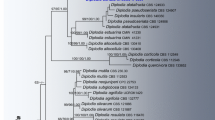Abstract
TheLaboulbenia exigua group comprises seven species. Three of these species are described as new to science, and two new varieties ofL. exigua and one new variety ofL. balazucii are distinguished and described. New taxa areL. yamadae, L. consobrina, L. gebleri, L. exigua var.yaeyamae, L. exigua var.melanolabiata andL. balazucii var.exilis. This fungus group is characterized by grayish yellow to gray-brown thalli with simple inner and outer appendages, dark-spotted or streaked receptacles, and perithecia containing narrow ascospores 3–4–(–5) µm in width; the species and varieties occur onChlaenius (Carabidae) and closely allied taxa. The bilobed apex of mature perithecium, owing to the rounded apices of the posterior apical cells of the outer wall cell rows, and 3-celled, curved inner appendage in young thalli, and the deciduous antheridium are also characteristic of this group.
Similar content being viewed by others
Literature cited
Balazuc, J. 1971. Notes sur les Laboulbéniales. III. Rectifications, synonymies et mises au point. Bull. mens. Soc. linn. Lyon40: 168–171, 211–216.
Balazuc, J. 1974. Laboulbéniales de France (suite). Bull. mens. Soc. linn. Lyon43: 12–21, 57–64, 73–79, 253–262, 295–315, 346–368.
Balazuc, J. 1982. Laboulbéniales (Ascomycètes) de Madagascar, des Comores et des Mascareignes. Bull. mens. Soc. linn. Lyon51: 6–27.
Ishikawa, M. 1948.Laboulbenia-rui no saishu. Coll. Breed.10: 304–305, 313. (In Japanese.)
Lee. Y.-B. 1986. Taxonomy and geographical distribution of the Laboulbeniales in Asia. Kor. J. Plant Tax.16: 89–185.
Lepesme, P. 1942. Une nouvelleLaboulbenia de France. Bull. Soc. Mycol. Fr.58: 190–191.
Lepesme, P. 1943. TroisLaboulbenia nouvelles parasites deChlaenius malgaches. Bull. Mus. nat, Hist. nat., Paris (2e sér.)15: 244–247.
Maire, R. 1916. Deuxième contribution à l'étude des Laboulbéniales de l'Afrique du Nord. Bull. Soc. Hist. nat. Afr. Nord7: 6–39. Pls. 1–2.
Picard, F. 1913. Contribution à l'étude des Laboulbéniacées d'Europe et du nord de l'Afrique. Bull. Soc. Mycol. Fr.29: 503–571. Pls. XXIX–XXXII.
Rossi, W. 1986. Su alcune specie diLaboulbenia nuove o interessanti della Sierra Leone. Accad. Naz. Lincei, Quaderno260: 77–96. Pls. I–III.
Sugiyama, K. 1973. Species and genera of the Laboulbeniales (Ascomycetes) in Japan. Ginkgoana2: 1–97. Pls. 1–27.
Sugiyama, K. 1979. On new species of the genusLaboulbenia (Laboulbeniomycetes, Ascomycotina) I. Trans. Mycol. Soc. Japan20: 141–147.
Tavares, I. I. 1985. Laboulbeniales (Fungi, Ascomycetes). Mycologia Memoir No. 9. J. Cramer, Braunschweig, Germany. 627 p.
Thaxter, R. 1896. Contribution toward a monograph of the Laboulbeniaceae. Mem. Amer. Acad. Arts Sci.12: 187–429. Pls. I–XXXVI.
Thaxter, R. 1902. Preliminary diagnoses of new species of Laboulbeniaceae-V. Proc. Amer. Acad. Arts Sci.38: 7–57.
Thaxter, R. 1908. Contribution toward a monograph of the Laboulbeniaceae. Part II. Mem. Amer. Acad. Arts Sci.13: 217–469. Pls. XXVIII–LXXI.
Author information
Authors and Affiliations
About this article
Cite this article
Terada, K. Laboulbenia exigua and related taxa (Ascomycetes, Laboulbeniales). Mycoscience 36, 293–309 (1995). https://doi.org/10.1007/BF02268605
Accepted:
Issue Date:
DOI: https://doi.org/10.1007/BF02268605




